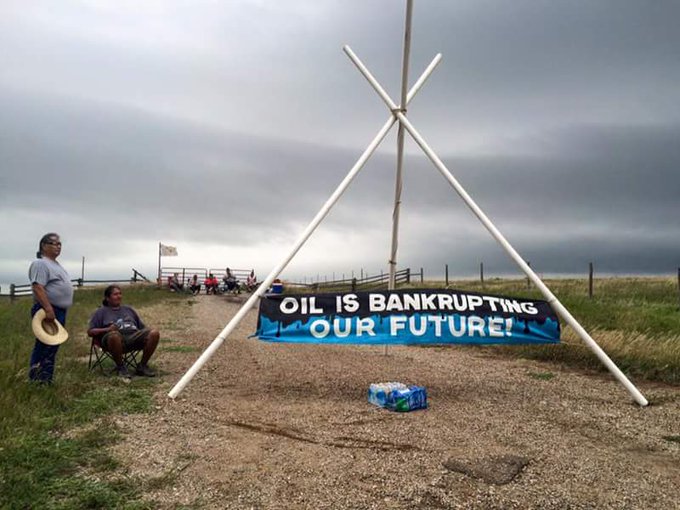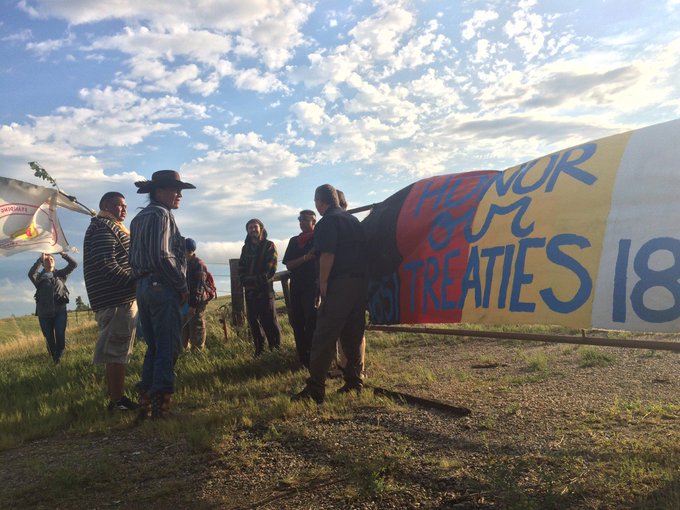Repost from the Chronicle Times, Cherokee, IA
[Editor: Significant quote: “Currently, almost 100% of the 944,000 barrels of crude oil produced daily from western North Dakota oil fields moves out over the U.S. railroad system.” – RS]
Energy Transfer sells share of Bakken Pipeline
By Loren G. Flaugh, Wednesday, August 31, 2016Rail shipments to lessen when pipeline operational
 According to an Energy Transfer Partners, L.P. (ETP) website, ETP and Sunoco Logistics Partners, L.P. announced they had signed an agreement to sell 36.75% of the Bakken Pipeline Project to MarEn Bakken Company, LLC. Marathon Petroleum Corporation and Canada based Enbridge Energy Partners, L.P. jointly own MarEn Bakken.
According to an Energy Transfer Partners, L.P. (ETP) website, ETP and Sunoco Logistics Partners, L.P. announced they had signed an agreement to sell 36.75% of the Bakken Pipeline Project to MarEn Bakken Company, LLC. Marathon Petroleum Corporation and Canada based Enbridge Energy Partners, L.P. jointly own MarEn Bakken.
Marathon Petroleum and Enbridge paid $2 billion in cash for the minority share of the Dakota Access Pipeline (DAPL) and its sister pipeline, the Energy Transfer Crude Oil Pipeline (ETCOP).
The DAPL consists of approximately 1,172 miles of 30-inch diameter pipeline from western North Dakota’s Bakken oil production region to the petroleum storage hub at Patoka, Illinois. The ETCOP is roughly 700 miles of existing, 30-inch diameter pipeline already converted from carrying natural gas to carrying the light sweet Bakken Crude oil. That converted pipeline starts at Patoka and terminates at Nederland, Texas near Houston.
Energy Transfer said the sale to Marathon Petroleum and Enbidge is to close in the 3rd quarter of 2016 and it’s subject to certain closing conditions. ETP will receive $1.2 billion and Sunoco will receive $800 million in cash when closing is finalized.
Energy Transfer said they plan to use the proceeds from the cash sale to pay down debt and to help fund their current growth projects.
Energy Transfer/Sunoco will own 38.25% of the DAPL. MarEn will own 36.75% and Phillips 66 will continue to own the remaining 25%. Energy Transfer will continue to oversee the ongoing construction of the approximately $3.8 billion pipeline project. Once the pipeline becomes operational later this year, Sunoco will be responsible for day-to-day operations of the pipeline.
Energy Transfer will quickly initiate another open season process and solicit additional shippers on its common-carrier crude oil pipeline to increase the daily flow rate from the current design capacity of 450,000 barrels per day to just under 600,000 barrels per day. The tariffs that ETP will assess petroleum companies that ship oil on the pipeline will pay off construction costs and provide revenue for day-to-day operations
A large subsidiary of Marathon Petroleum has already committed to participate in this upcoming open season and will make a long-term commitment to ship a large volume of Bakken crude oil to the Patoka petroleum hub. Enbridge owns crude oil storage tanks at Patoka and existing pipelines that go in to and out of this vital petroleum transshipment hub.
When ETP proposed the DAPL back on June 25, 2014, the pipeline was designed for transporting 320,000 barrels of light sweet Bakken crude oil per day. Energy Transfer said that they would solicit additional shipper interest to increase the daily flow rate. Additionally, Energy Transfer said they were in discussions with Sunoco to seek their participation in a potentially significant equity partnership.
Then on September 22, 2014, Energy Transfer announced that they intended to initiate an Expansion Open Season to acquire additional crude oil transportation services on the DAPL. This Expansion Open Season was successful when additional shippers signed long-term commitments increasing the daily throughput to 450,000 barrels per day.
With the pending ETP open season in the coming weeks, this anticipated flow-rate increase of upwards of 570,000 barrels per day will result in the DAPL moving a substantial volume of the daily crude oil produced from western North Dakota’s Bakken/Three Forks petroleum production areas.
According to the North Dakota Bakken Daily Oil Production News website, the daily production level of Bakken crude oil stood at 994,727 barrels per day as of May 31, 2016. This is a small increase from the previous month. However, both production figures are down significantly from June 30, 2015 when the Bakken oil field was producing at the rate of 1,153,000 barrels per day. The Bakken oil fields had been yielding almost 1,200,000 barrels per day in 2014 when prices for crude oil were much higher than today.
The U. S. Energy Information Administration (EIA) recorded a price for crude oil at $105 per barrel in June of 2013. It was in July of 2014 when oil prices dropped below $100 per barrel. One year ago, in June of 2015, the EIA reported a price per barrel of around $60. Earlier this year, in February, the price per barrel plunged to just above $26 per barrel. Today’s price per barrel is around $40 and still expected to fall more.
The daily production rates for crude oil in the Bakken oil fields are rising and falling right along with the fluctuating prices for crude oil and will continue to due to the current over-supply of crude oil in the world oil markets.
Currently, almost 100% of the 944,000 barrels of crude oil produced daily from western North Dakota oil fields moves out over the U.S. railroad system. That is because there are no significant crude oil pipeline systems originating from the Bakken region currently available for moving this huge volume of light sweet crude oil into the broader U.S. pipeline distribution system.
Once the 600,000 barrel per day DAPL begins commercial operations later this year, it will be the first major pipeline to move Bakken crude oil. However, that still leaves about 400,000 barrels per day for railroad shipment. A 100-car Bakken crude oil unit train can carry about 3,000,000 gallons of oil.
According to North Dakota statistics, Burlington Northern & Santa Fe Railroad (BNSF) hauls out about 75% of the crude oil that leaves the Bakken region. Union Pacific and CSX Corporation are other rail carriers that move Bakken crude oil. Some Bakken crude oil goes north into Canada and is moved east or west to crude oil refineries located as far east as Nova Scotia.
The most recent crude oil unit train derailment happened on June 3, 2016 when a 96-car Union Pacific unit train carrying Bakken crude oil derailed while moving through the Columbia River Gorge near Mosier, Oregon. Fourteen of the tanker cars derailed, ruptured and caught fire. Approximately 42,000 gallons of crude oil spilled. A federal investigation revealed that broken bolts joining two rails caused the accident.
The Iowa Homeland Security and Emergency Management Department tracks how much Bakken crude oil moves through Iowa. According to figures from early 2015, BNSF moves Bakken crude oil through Iowa on one heavily used route through Lyon, Sioux and Plymouth Counties and into eastern Nebraska. Another heavily used BNSF route crosses southern Iowa. When daily North Dakota crude oil production rates peaked in 2014 and 2015, roughly 12 to 18 crude oil unit trains per week used the two BNSF routes.
The Association of American Railroads did a study of U. S. Rail Crude Oil Traffic in November of 2015. Their summary noted; U.S. crude oil production has risen sharply in recent years, with much of the increased output moving by rail. In 2008, U.S. Class I railroads originated 9,500 carloads of crude oil. In 2014, they originated 493,146 carloads, an increase of nearly 5,100 percent. Rail crude oil volumes in 2015 will be lower than in 2014. Additional pipelines will probably be built in the years ahead, but the competitive advantages railroads offer–including flexibility to serve disparate markets–could keep them in the crude oil transportation market long into the future.






